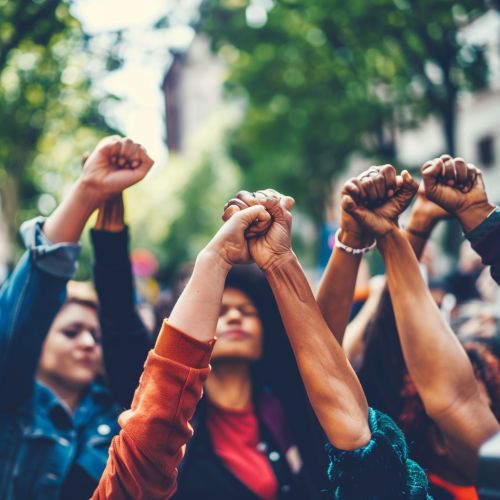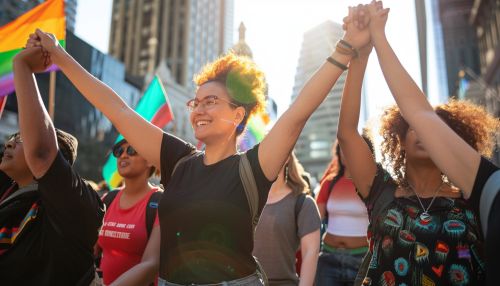Social action: Difference between revisions
No edit summary |
No edit summary |
||
| Line 62: | Line 62: | ||
Social action is a multifaceted and dynamic process that plays a crucial role in shaping societies. It encompasses a wide range of activities, from individual behaviors to large-scale social movements, and involves complex interactions between individuals, groups, and institutions. Understanding the mechanisms and challenges of social action is essential for analyzing social change and addressing social issues. | Social action is a multifaceted and dynamic process that plays a crucial role in shaping societies. It encompasses a wide range of activities, from individual behaviors to large-scale social movements, and involves complex interactions between individuals, groups, and institutions. Understanding the mechanisms and challenges of social action is essential for analyzing social change and addressing social issues. | ||
[[Image:Detail-79673.jpg|thumb|center|Group of diverse people holding hands and protesting peacefully in a public square.]] | [[Image:Detail-79673.jpg|thumb|center|Group of diverse people holding hands and protesting peacefully in a public square.|class=only_on_mobile]] | ||
[[Image:Detail-79674.jpg|thumb|center|Group of diverse people holding hands and protesting peacefully in a public square.|class=only_on_desktop]] | |||
== See Also == | == See Also == | ||
Latest revision as of 15:22, 19 May 2024
Introduction
Social action is a concept in sociology that refers to actions taken by individuals or groups that are intended to influence or change social structures, relationships, or institutions. This concept is central to understanding how societies function and evolve, as it encompasses a wide range of activities from everyday interactions to large-scale social movements. Social action is not merely individual behavior; it is behavior that takes into account the actions and reactions of other individuals and is oriented towards them.
Theoretical Foundations
Max Weber's Definition
Max Weber, a foundational figure in sociology, defined social action as an action that takes into account the behavior of others and is thereby oriented in its course. According to Weber, social action can be classified into four types: traditional, affective, value-rational, and instrumental-rational. Traditional action is guided by customs and habits, affective action by emotions, value-rational action by a belief in the inherent value of an action, and instrumental-rational action by a calculated pursuit of goals.
Talcott Parsons and Structural Functionalism
Talcott Parsons expanded on Weber's ideas through his theory of structural functionalism. Parsons viewed social action as a system of interrelated parts that work together to maintain stability and order in society. He emphasized the role of social norms and values in guiding individual behavior and maintaining social equilibrium.
Symbolic Interactionism
Symbolic interactionism, a theoretical framework developed by George Herbert Mead and Herbert Blumer, focuses on the micro-level of social action. It examines how individuals create and interpret symbols and meanings in their interactions with others. According to this perspective, social action is a dynamic process of meaning-making and negotiation.
Types of Social Action
Collective Action
Collective action refers to actions taken by a group of individuals to achieve a common goal. This can include protests, strikes, and social movements. Collective action often involves coordination and cooperation among group members and can lead to significant social change.
Individual Action
Individual action, while seemingly personal, can have broader social implications. For example, an individual's decision to recycle or boycott certain products can contribute to larger environmental or social movements. Individual actions are often influenced by social norms, values, and expectations.
Institutional Action
Institutional action involves actions taken by organizations or institutions, such as governments, corporations, or non-profits, to influence social structures or policies. This can include legislative changes, corporate social responsibility initiatives, and public health campaigns.
Mechanisms of Social Action
Social Networks
Social networks play a crucial role in facilitating social action. They provide channels for communication, coordination, and mobilization. Social networks can amplify the impact of individual actions by connecting like-minded individuals and groups.
Social Capital
Social capital refers to the resources and benefits that individuals and groups gain from their social networks. It includes trust, reciprocity, and social support. High levels of social capital can enhance the effectiveness of social action by fostering cooperation and collective efficacy.
Social Movements
Social movements are organized efforts by a large group of people to achieve social change. They often arise in response to perceived injustices or inequalities and can take various forms, including protests, advocacy, and lobbying. Social movements can be local, national, or global in scope.
Case Studies
Civil Rights Movement
The Civil Rights Movement in the United States is a prominent example of social action. It involved a series of coordinated efforts by African Americans and their allies to end racial segregation and discrimination. Key tactics included nonviolent protests, legal challenges, and grassroots organizing.
Environmental Activism
Environmental activism encompasses a wide range of social actions aimed at protecting the environment and promoting sustainability. This includes actions such as lobbying for environmental regulations, participating in clean-up efforts, and raising awareness about climate change.
Digital Activism
Digital activism, or cyber-activism, leverages digital technologies and social media platforms to facilitate social action. It allows for rapid dissemination of information, mobilization of supporters, and coordination of activities. Examples include online petitions, hashtag campaigns, and virtual protests.
Challenges and Criticisms
Collective Action Problem
One of the main challenges of social action is the collective action problem, which occurs when individuals have little incentive to contribute to a collective effort because they can benefit from the efforts of others without participating. This can lead to free-riding and undermine the effectiveness of social action.
Resource Mobilization
Effective social action often requires significant resources, including time, money, and expertise. Mobilizing these resources can be challenging, particularly for grassroots movements and marginalized groups. Resource mobilization theory examines how social movements acquire and deploy resources to achieve their goals.
Political and Social Resistance
Social action can face resistance from established power structures and vested interests. Governments, corporations, and other institutions may use various tactics, such as repression, co-optation, and propaganda, to undermine social action and maintain the status quo.
Conclusion
Social action is a multifaceted and dynamic process that plays a crucial role in shaping societies. It encompasses a wide range of activities, from individual behaviors to large-scale social movements, and involves complex interactions between individuals, groups, and institutions. Understanding the mechanisms and challenges of social action is essential for analyzing social change and addressing social issues.


